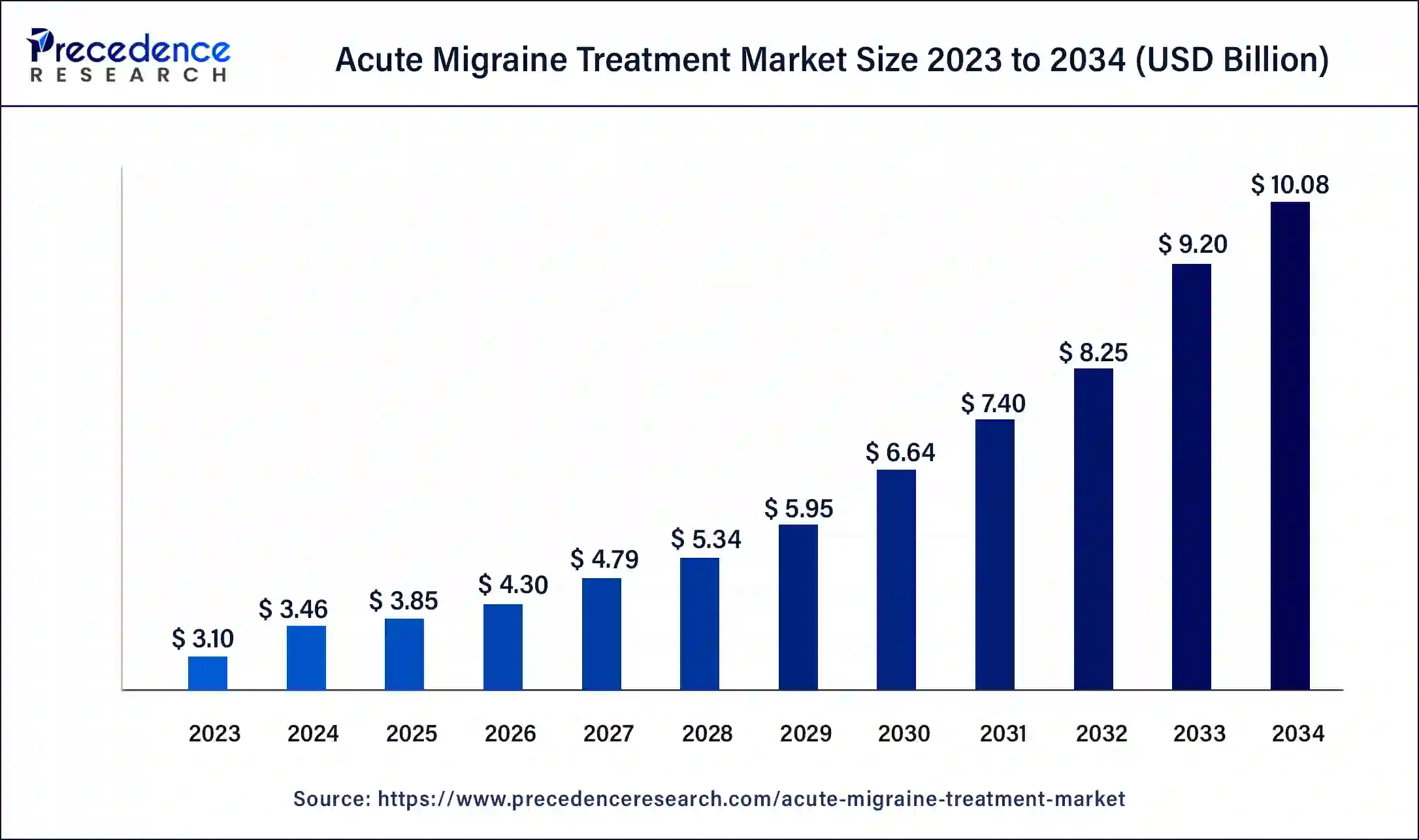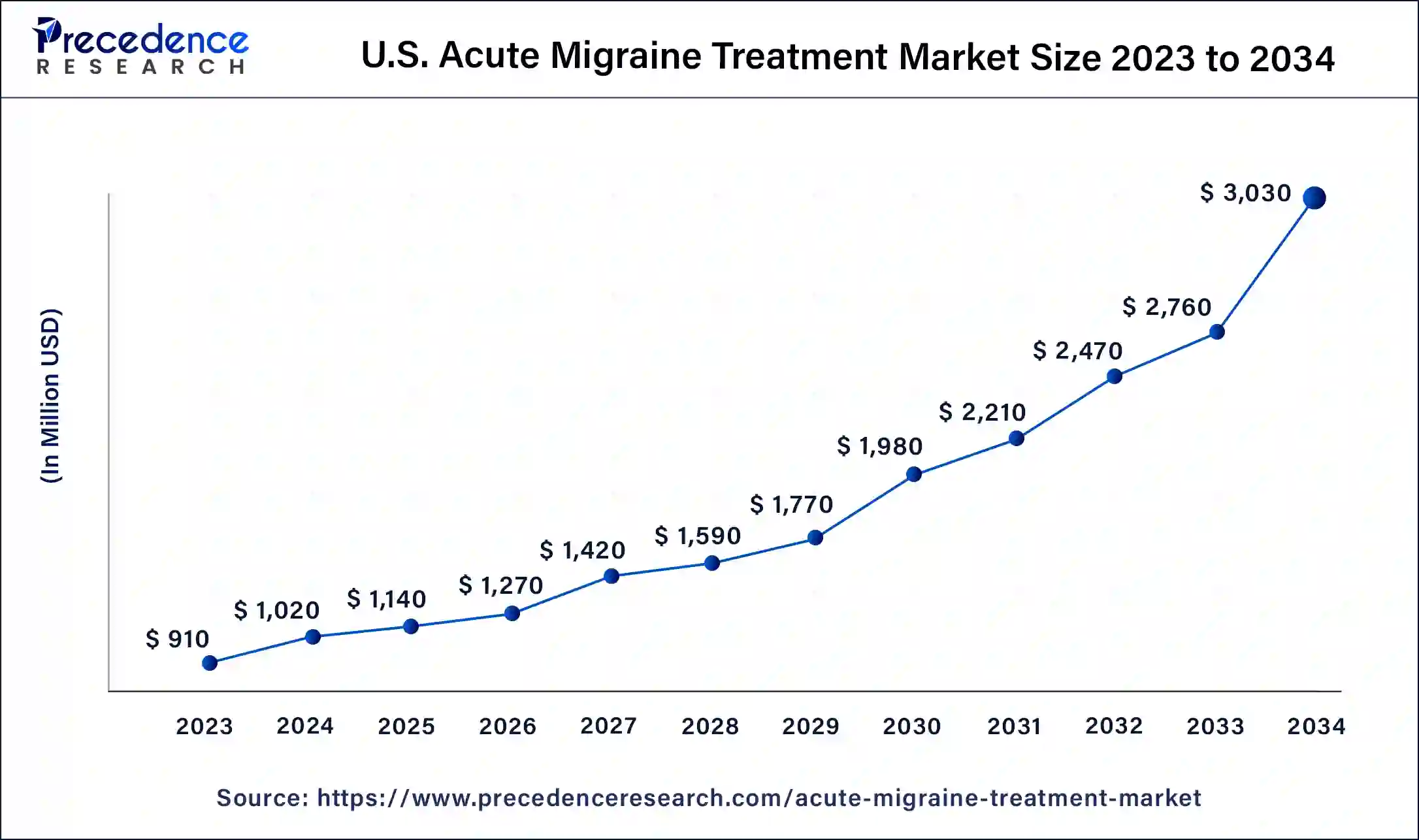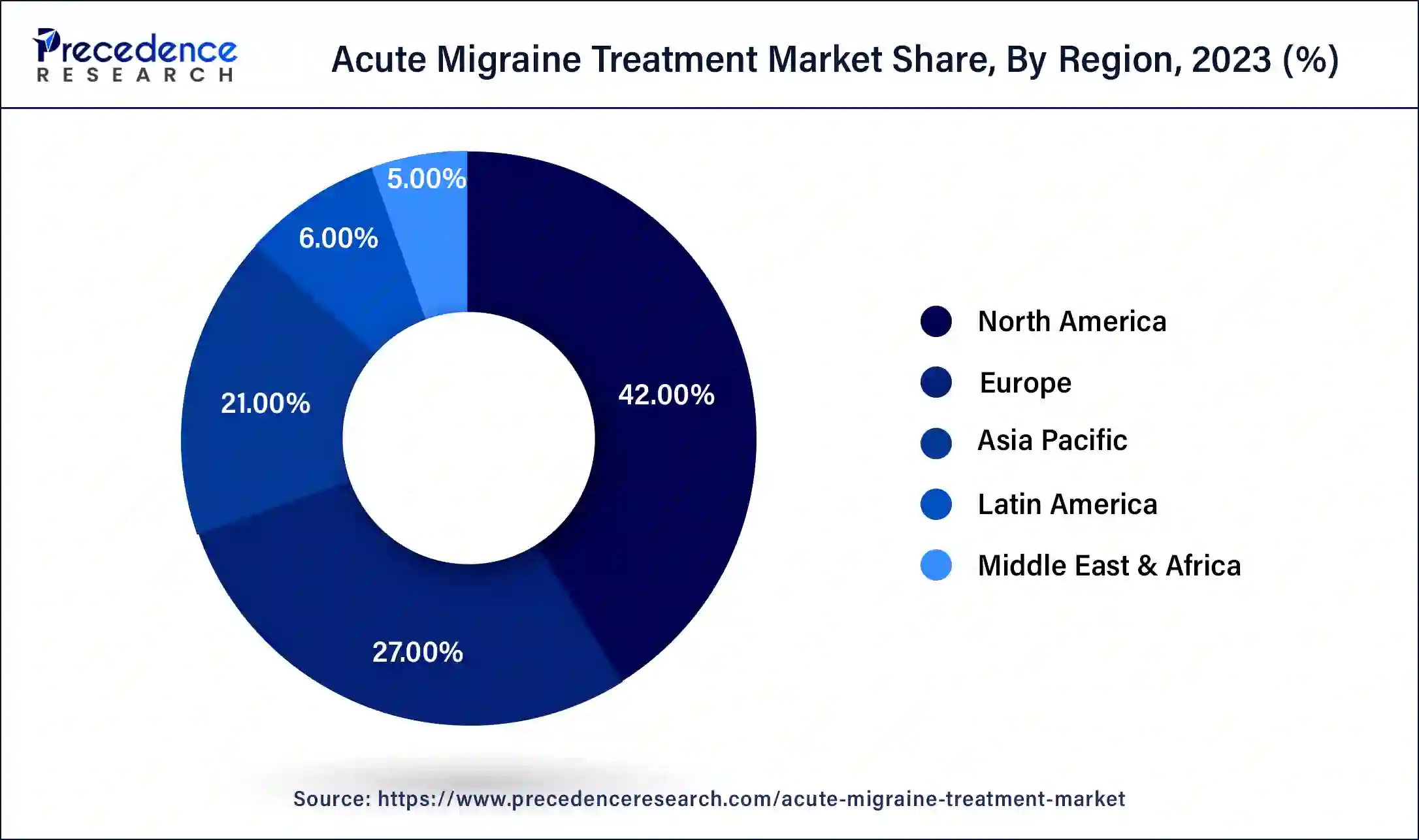January 2025
Acute Migraine Treatment Market (By Drug Type: Triptans, CGRP Antagonist, NSAID Drugs, Beta-adrenergic, Ergot Alkaloids, Others, By Route Of Administration: Oral, Injection, Others; By Distribution Channel: Hospital Pharmacies, Retail Pharmacies, Online Pharmacies) - Global Industry Analysis, Size, Share, Growth, Trends, Regional Outlook, and Forecast 2024-2034
The global acute migraine treatment market size was USD 3.10 billion in 2023, calculated at USD 3.46 billion in 2024 and is expected to reach around USD 10.08 billion by 2034, expanding at a CAGR of 11.30% from 2024 to 2034. The rising prevalence of acute migraine due to the hectic lifestyle worldwide and the recognition of migraine as a severe neurological disease are the major factors driving the market globally.

The U.S. acute migraine treatment market size was estimated at USD 910 million in 2023 and is projected to surpass around USD 3,030 million by 2034 at a CAGR of 11.50% from 2024 to 2034.

North America dominated the acute migraine treatment market due to the rising prevalence of migraine illness in the region. With a large population affected by migraines and a growing awareness of the condition's impact on individuals' quality of life, the North American market for acute migraine treatment continues to see significant investment in research and development. Marketing efforts are also the reason for reaching out and supporting those in need of relief from migraine symptoms.
The region is a significant market for acute migraine treatment. Within this region, various pharmaceutical companies develop, manufacture, and distribute medications and therapies specifically designed to detect the symptoms of acute migraines. These treatments target unbearable pain, nausea, and sensitivity to light and sound. These symptoms are commonly associated with migraines. Additionally, the market includes a range of prescription and over-the-counter medications, as well as medical devices and therapies such as neuromodulation devices and injectable medications.

In the United States, the acute migraine treatment market is a dynamic sector driven by a large population affected by migraines. Pharmaceutical companies invest heavily in research and development to create innovative medications and therapies. The market includes a wide range of prescription and over-the-counter options, as well as medical devices and therapies. With a strong healthcare infrastructure and high awareness of migraine prevalence, the acute migraine treatment market in the U.S. continues to grow.
In Canada, the acute migraine treatment market shares similarities with the U.S. but also faces unique challenges. The market is divided by a smaller population but still experiences significant demand for migraine relief products. Pharmaceutical companies adapt their offerings to meet the needs of Canadian consumers, considering factors such as regulatory requirements and healthcare reimbursement policies. Despite these challenges, the Canadian market for acute migraine treatment remains a vital area of focus for healthcare providers and pharmaceutical companies.
Asia Pacific is the fastest-growing region in the acute migraine treatment market due to the increasing expenditure on healthcare systems along with the growing disease awareness. For the region's market, India represents a vast and rapidly growing market. With a significant population affected by migraines, there is a high demand for effective treatments.
Market research in India focuses on understanding the unique healthcare needs of its diverse population, including factors such as cultural preferences, accessibility to healthcare services, and affordability of treatments. Pharmaceutical companies fabricated their products to meet these specific requirements, offering a range of medications and therapies targeted at alleviating migraine symptoms quickly and efficiently. As India's healthcare infrastructure continues to improve and awareness of migraines increases, the acute migraine treatment market in the country presents significant opportunities for growth and innovation.
In China, the acute migraine treatment market is also experiencing rapid development. With a large population and increasing urbanization, there is a growing awareness of migraines and a demand for effective treatment options. China mainly focuses on understanding consumer preferences, healthcare practices, and regulatory environments to develop tailored strategies for pharmaceutical companies. Additionally, advancements in technology and healthcare infrastructure contribute to the expansion of treatment options, including innovative medications and therapies. As China continues to prioritize healthcare improvements and access to treatment, the market is poised for significant growth in the upcoming years.
In Japan, the acute migraine treatment market is driven by advanced healthcare infrastructure and a population with a high awareness of health issues. Pharmaceutical companies invest in research and development to create innovative medications and therapies that effectively alleviate migraine symptoms. With a strong emphasis on quality and safety, Japanese consumers place trust in established brands and products. As Japan's aging population continues to increase, the demand for acute migraine treatments is expected to grow, presenting opportunities for both domestic and international companies to meet the needs of this market segment.
The acute migraine treatment market is a sector of the healthcare industry focused on providing relief for people experiencing intense headaches, known as migraines. Migraines can be incredibly hard to deal with. And often causing severe pain, nausea, sensitivity to light and sound, and other symptoms that can adversely affect even a mundane work of daily life.
In addition to oral medications, some treatments are available in nasal spray or injectable forms for rapid relief, particularly for individuals who experience nausea or have difficulty swallowing during a migraine attack. Aside from medications, the acute migraine treatment market also includes non-pharmacological approaches, such as, CBT means cognitive behavioral therapy. It can help individuals develop coping strategies to manage migraine triggers, stress, and pain perception.
Biofeedback techniques teach individuals to control physiological responses associated with migraines, such as muscle tension and heart rate, through relaxation and stress reduction techniques. Lifestyle changes, such as maintaining a regular sleep schedule, managing stress, staying hydrated, and avoiding trigger foods or environmental factors, can help reduce the frequency and severity of migraine attacks.
In the acute migraine treatment market, pharmaceutical companies develop medications specifically designed to alleviate migraine symptoms quickly and effectively. These medications may include which are basically a class of drugs commonly used to treat migraines. They work by contracting a blood vessel in the brain and blocking pain pathways. These medications help prevent migraines from occurring and reduce the frequency and severity of attacks. Medications, such as ibuprofen, naproxen, and aspirin, can also be effective in relieving migraine symptoms, particularly when taken at the onset of an attack.
| Report Coverage | Details |
| Global Market Size by 2034 | USD 10.08 Billion |
| Global Market Size in 2023 | USD 3.10 Billion |
| Global Market Size in 2024 | USD 3.46 Billion |
| Growth Rate from 2024 to 2034 | CAGR of 11.30% |
| Largest Market | North America |
| Base Year | 2023 |
| Forecast Period | 2024 to 2034 |
| Segments Covered | Drug Type, Route Of Administration, Distribution Channel, and Region |
| Regions Covered | North America, Europe, Asia-Pacific, Latin America, and Middle East & Africa |
Recognition of migraine
A significant market driver for the acute migraine treatment market is the growing awareness and recognition of migraines as a serious neurological disorder. For many years, migraines were often considered just bad headaches, but now there's a better understanding of their complex nature and the significant impact they can have on individuals' lives. As awareness grows, more people are seeking diagnosis and treatment for their migraines, driving demand for effective therapies.
Now, healthcare providers are becoming more proactive in diagnosing and managing migraines, leading to increased prescription rates for migraine-specific medications. Advancements in medical research have led to the development of new and improved treatments, such as CGRP inhibitors, which specifically target the underlying mechanisms or causes of migraines. Such an innovation has expanded the options available to patients and healthcare providers, further driving growth in the acute migraine treatment market.
High-cost treatment
A major restraint of the acute migraine treatment market is the higher cost associated with some migraine medications. Certain treatments, especially newer and more advanced medications like CGRP inhibitors, can be expensive, making them inaccessible to some patients without adequate insurance coverage. The high cost of migraine medications can create barriers to access to advanced treatment, especially for those with less financial back-ups. And thus limiting treatment options for individuals who may benefit from them.
Healthcare systems and insurance providers may face challenges in covering the cost of expensive migraine treatments for large populations. This leads to potential reimbursement issues and a financial load on healthcare budgets. This can result in undertreatment or reliance on less effective or more affordable alternatives, potentially leading to ineffective outcomes for patients. It is the main reason for hindering access to effective therapies for some patients and creating challenges for healthcare providers and payers in managing treatment costs.
Personalized medicine
A future opportunity in the acute migraine treatment market lies in the developments of personalized medicine tailored for individual patients. As our understanding of the underlying mechanisms of migraines continues to evolve with time, along with advancements in technology such as genetics and biomarker identification, there is growing potential to identify specific subtypes of migraines and tailor treatments accordingly.
By including a personalized medicine strategy, healthcare providers can optimize treatment results by selecting therapies that are most likely to be effective for each patient based on their unique genetic conditions, biomarker profiles, and other personal characteristics. This approach can help minimize the trial-and-error prescription method followed by medical professionals and improve overall treatment efficacy and patient satisfaction.
Personalized medicine presents an exciting future opportunity in the acute migraine treatment market. It may lead to the development of novel therapies targeting specific migraine subtypes or pathways, which again helps expand the range of treatment options available to patients. It offers the potential to revolutionize how migraines can be diagnosed and treated, ultimately improving the outcome for patients with different types of migraine issues.
The CGRP antagonist segment is estimated to hold the largest market share globally in the acute migraine treatment market. CGRP antagonists are a type of medication used to treat acute migraines. They work by blocking the action of a protein called calcitonin gene-related peptide (CGRP), which is involved in migraine attacks. In recent years, CGRP antagonists have become a popular option for migraine treatment because they can provide fast relief with fewer side effects compared to some other medications. This has led to a growing market for these drugs.
Recent data shows that sales of CGRP antagonists have been steadily increasing, with projections indicating continued growth in the coming years. This is driven by factors such as increased awareness of migraine treatment options, the development of new and more effective CGRP antagonist drugs and expanding access to healthcare services.
The oral segment held the largest share of the market. Significant innovation and growth have been made in the oral segment of the acute migraine treatment market. Oral medications are pills or tablets taken by mouth to relieve migraine symptoms quickly and conveniently. Recent data indicates a rise in demand for oral migraine treatments due to their ease of use and effectiveness in managing symptoms like pain, nausea, and sensitivity to light and sound. These advancements aim to provide rapid relief for migraine sufferers, allowing them to resume their daily activities sooner.
Market analysis reveals a steady increase in sales of oral migraine medications, with projections suggesting continued expansion. One unique aspect of this segment is the development of novel formulations and delivery methods, such as orally disintegrating tablets and fast-acting formulations. Factors contributing to this growth include the introduction of new drugs with improved efficacy and fewer side effects, as well as increasing accessibility to these treatments for patients worldwide.
The hospital pharmacy segment held the largest market share in 2023. The hospital pharmacy segment of the acute migraine treatment market plays a crucial role in providing specialized care to patients experiencing severe migraine attacks that require medical intervention.
In this segment, hospitals keep a stock of a wide range of migraine medications, including intravenous (IV) formulations and injectables, to provide to patients who present with acute migraine symptoms in the emergency department or inpatient settings. Market data indicates that the hospital pharmacy segment for acute migraine treatment is experiencing continuous growth, driven by factors such as increasing awareness of migraine as a neurological condition that requires specialized care, advancements in migraine treatment protocols, and improvements in hospital infrastructure and resources.
The hospital pharmacy segment focuses on delivering rapid and effective relief to patients during the migraine period. Hospitals often have access to a variety of medications, including opioids, antiemetics, and specialized migraine-specific treatments, to address different aspects of migraine symptoms such as pain, nausea, and vomiting. Additionally, hospitals may employ multidisciplinary teams of healthcare professionals, including neurologists, pharmacists, and nurses, who collaborate to develop personalized treatment plans for migraine patients based on their individual needs and medical history.
Segments Covered in the Report
By Drug Type
By Route of Administration
By Distribution Channel
By Geography
For inquiries regarding discounts, bulk purchases, or customization requests, please contact us at sales@precedenceresearch.com
No cookie-cutter, only authentic analysis – take the 1st step to become a Precedence Research client
January 2025
March 2025
September 2024
September 2024